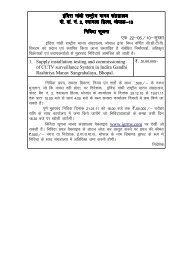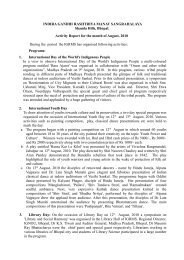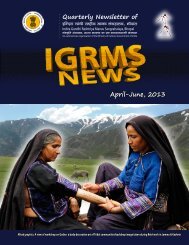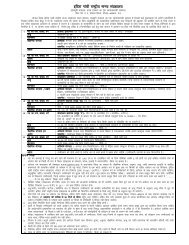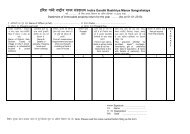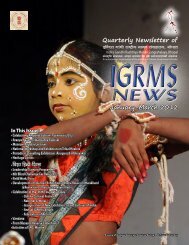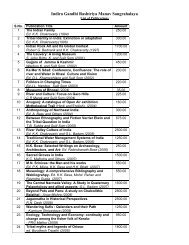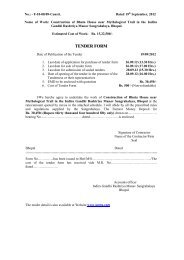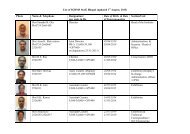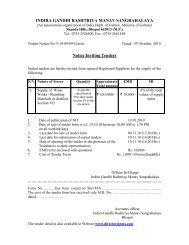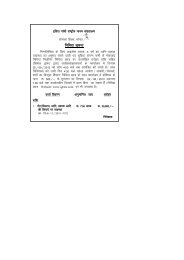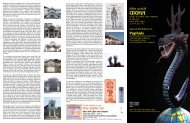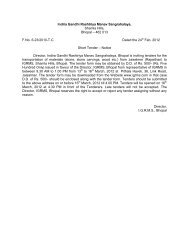Indira Gandhi Rashtriya Manav Sangrahalaya (National ... - IGRMS
Indira Gandhi Rashtriya Manav Sangrahalaya (National ... - IGRMS
Indira Gandhi Rashtriya Manav Sangrahalaya (National ... - IGRMS
You also want an ePaper? Increase the reach of your titles
YUMPU automatically turns print PDFs into web optimized ePapers that Google loves.
<strong>Indira</strong> <strong>Gandhi</strong> <strong>Rashtriya</strong> <strong>Manav</strong> <strong>Sangrahalaya</strong> 287<br />
movement within and between these themes. This conceptual approach was<br />
adopted by the Executive Council and S. Navlakha was engaged to detail this<br />
approach into a report for discussion.<br />
Navlakha’s report (1994) stressed the need for presentation of multiple<br />
perspectives eschewing a privileged epistemology including non-privileged voices;<br />
to describe not only past but also present; not only others, but also ourselves; to<br />
decentralize, destabilize and decolonize essentialist and reductionist narratives of<br />
culture; to transcend cognitive and non-cognitive fact value distinctions, and to<br />
offer a dialogical, relativist, open ended view of culture. The report warned against<br />
mixing culture and biology in the depiction of evolution, and suggested description<br />
of different culture-scapes, based on literate and pre-literate modes of subsistence,<br />
as synchronic rather than chronologically fixed points. The report also stressed<br />
the need for putting the historic periods, specially the last two three centuries,<br />
and mostly, the 20 th century in the context of intellectual history of mankind,<br />
with a focus on modernity, ancient literary civilization (India), oral traditions,<br />
architecture, settlement and livelihood styles, and relationships with environment,<br />
on community structure, socialization and distribution patterns and on aesthetic<br />
value and creative expression.<br />
A comment on this report was about the difficulty of translating abstract<br />
ideas into three dimensional realities and about the need to carryout the task as<br />
an in-house exercise. The INC-ICOM <strong>National</strong> Chapter meet held in the Museum<br />
in 1994 together with several members of the Governing Committee suggested<br />
updating the concept and programme content, and the 18 th meeting of the<br />
Executive Council desired the Director, <strong>IGRMS</strong>, K.K. Chakravarty, to detail the<br />
ideas of the concept and display.<br />
Chakravarty, in his initial notes pointed out that until then (1994) the<br />
discussions on the concept was confined to the Museum’s task of indoor and<br />
outdoor exhibitions, and not explored the ways and means whereby the major<br />
objectives of the RMS Samiti to be achieved, apart from the exhibitions. He<br />
stressed the need to look into tangible and intangible elements of traditional<br />
knowledge systems including solution for problems of health, nutrition, man’s<br />
relation with plants and animal, and to take exhibitions and salvage initiatives to<br />
remote parts of the country. The <strong>IGRMS</strong> should widen its spectrum of activities<br />
to demonstrate simultaneous validity of various cultures; the aesthetic quality of<br />
local resource based traditional architecture, technologies, arts, crafts and the ecofriendly<br />
conservation practices cherished and transmitted by the communities.<br />
The <strong>IGRMS</strong>, through its display and field programmes, should caution the people<br />
against unprecedented destruction of ecology. It should propagate the ability of<br />
folk and tribal communities to recognize, codify, classify, present and use their<br />
knowledge in harvesting the natural resources; their instinct to respect the tone<br />
and rhythm of nature and their perception of community rights and obligations.<br />
It should play a catalyst role between rural communities and the different academic



